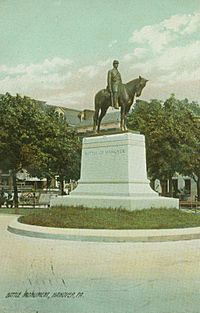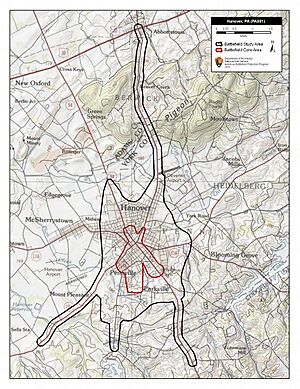Battle of Hanover facts for kids
Quick facts for kids Battle of Hanover |
|||||||
|---|---|---|---|---|---|---|---|
| Part of the American Civil War | |||||||
 "The Pickett," a commemorative statue in Hanover's Center Square; sculpted by Cyrus E. Dallin. |
|||||||
|
|||||||
| Belligerents | |||||||
| Commanders and leaders | |||||||
| Judson Kilpatrick | J.E.B. Stuart | ||||||
| Strength | |||||||
| ~5,000 | ~6,000 | ||||||
| Casualties and losses | |||||||
| 215 | 117 | ||||||
The Battle of Hanover happened on June 30, 1863. It took place in Hanover, Pennsylvania, during the Gettysburg Campaign of the American Civil War. Confederate cavalry, led by J.E.B. Stuart, was riding north. They wanted to get around the Union forces.
Stuart's soldiers attacked a Union cavalry group. They pushed them through the streets of Hanover. Soon, Union General Elon J. Farnsworth's soldiers arrived. They counterattacked, pushing back the Confederates. General Stuart himself was almost captured!
Stuart quickly counterattacked. But General George Armstrong Custer's Michigan Brigade joined Farnsworth. The Union soldiers held their ground. The battle ended in a stalemate. Stuart had to keep moving north and east. This delayed him from rejoining General Robert E. Lee's main army. Lee's army was gathering near Gettysburg, Pennsylvania.
| Top - 0-9 A B C D E F G H I J K L M N O P Q R S T U V W X Y Z |
Why Did the Battle of Hanover Happen?
The Armies Move North
In June 1863, General Robert E. Lee moved his Confederate army north. They marched through the Shenandoah Valley into Pennsylvania. Parts of his cavalry, led by J.E.B. Stuart, rode east. They were trying to get around the Union Army.
Stuart's cavalry raided towns in eastern Maryland. They captured prisoners and supplies. They also cut Union communication lines. But Stuart was not able to keep an eye on the Union army. He couldn't tell Lee where they were.
Union Cavalry Spreads Out
Stuart headed north to meet Lee's army. Meanwhile, Union cavalry commander Alfred Pleasonton was riding west of Stuart. Pleasonton ordered his cavalry groups to spread out. They needed to watch for any Confederate soldiers.
General Hugh Judson Kilpatrick's cavalry was on the Union's right side. Most of his men rode through Hanover early on June 30. The townspeople were very happy to see them. Just three days before, Confederate soldiers had raided Hanover.
Hanover's Recent Troubles
Confederate Lt. Col. Elijah V. White's cavalry had raided Hanover. They had followed the railroad from Gettysburg. White's soldiers took horses, food, and supplies. They often paid with Confederate money that was not worth much.
White's raiders also destroyed the town's telegraph wires. This cut off Hanover from the outside world. They also attacked the nearby Hanover Junction train station. So, the arrival of Kilpatrick's Union soldiers was a welcome surprise. The people of Hanover greeted them warmly with food and drinks.
Stuart's Slow March
Most of Kilpatrick's men soon left Hanover. They rode north towards Abbottstown. Kilpatrick left a small group behind. They were to guard the roads south and west of Hanover.
At the same time, Stuart was moving north into Pennsylvania. He heard that Union cavalry was near Littlestown, Pennsylvania. So, he changed direction and headed towards Hanover. His journey was very slow. He had captured over 125 supply wagons. These heavy wagons made him move slowly. He also had a small fight with Delaware cavalry on June 29. This delayed him even more.
The Battle Begins in Hanover
First Shots Fired
Around 10:00 a.m. on June 30, the battle started. The rear guard of the 18th Pennsylvania Cavalry Regiment met Confederate soldiers. This happened about three miles southwest of Hanover. A Confederate soldier was killed, and several were hurt.
Soon after, 25 Union soldiers were captured. They were from the 18th Pennsylvania. They were taken by the 13th Virginia Cavalry. This was the first group of Stuart's cavalry to arrive. There were also smaller fights near Littlestown that morning.
Fighting in the Streets
Southwest of Hanover, at a place called Pennville, the battle got more intense. The 2nd North Carolina Cavalry attacked the 18th Pennsylvania. They split the Union group in two. The Union survivors ran back through Hanover's streets.
Just then, Stuart's horse artillery arrived. They quickly set up their cannons and began firing. Confederates entered the town as the Pennsylvanians fled. But General Farnsworth quickly moved the 5th Regiment New York Volunteer Cavalry into position. They attacked the Confederate side in the streets. This forced the North Carolina soldiers to leave the town.
The commander of the 2nd North Carolina, William H. F. Payne, was captured. His horse died and threw him into a tanning vat. A Union soldier pulled him out and took him prisoner.
Stuart's Escape and Kilpatrick's Arrival
More of Stuart's men arrived, including General Stuart himself. They met more Union soldiers near the Karle Forney farm. Stuart and a staff officer were almost surrounded. They escaped by jumping their horses over a 15-foot ditch!
General Kilpatrick heard the gunfire. He raced south towards Hanover. His horse died in the town square from the fast ride. Kilpatrick quickly set up his men around Hanover. They blocked some streets with barrels and wagons. Around noon, the fighting at the Forney farm stopped. Kilpatrick placed Custer's newly arrived soldiers on the farm. They waited for what would happen next.
Artillery Duel
When Fitzhugh Lee's Virginia brigade arrived, Stuart moved his men. They took a new position on a ridge. This ridge stretched from the Keller Farm to Mount Olivet Cemetery. Kilpatrick also moved his soldiers. He put Custer and Farnsworth's brigades in a better defensive line. Then he brought up his cannons.
At 2 p.m., Wade Hampton III brought his soldiers and cannons into position. They were near Mount Olivet Cemetery. This was on the far right side of Stuart's line. An artillery duel began. Cannons fired shells over the town for about two hours. Shell fragments hit houses. They almost hit a woman and her daughter who had just left their balcony.
During the long cannon fight, Custer's soldiers moved forward. They were within 300 yards of the Confederate line. They managed to secure the Littlestown-Frederick Road. This opened a way for them to communicate with another Union army group. Neither Stuart nor Kilpatrick made any big attacks after this. Both sides just had small skirmishes.
What Happened After the Battle?
Stuart's Long Journey
Stuart slowly pulled back, protecting his captured wagons. He moved northeast through Jefferson towards York. He had heard that General Early's Confederate division was in York.
On the way, Stuart learned that Early had left York. Early's men had marched northwest. So, Stuart changed course. He headed north through the night on winding country roads. He was still trying to find Early or another Confederate general, Richard S. Ewell.
The front of Stuart's 17-mile long column reached Dover at 2:00 a.m. on July 1. The very end of his column arrived by 8:00 a.m. Stuart learned that Early had passed through Dover. Early was heading west to meet the main army.
Missed Connections and Delays
Stuart released over 200 Union prisoners. He gave his soldiers a much-needed six-hour rest. What Stuart didn't know was that a big battle was starting at Gettysburg. While he rested, Confederate and Union soldiers clashed there.
Stuart continued his tiring march. He seized over 1,000 fresh horses from farmers. He left some of his soldiers and the wagons at Dillsburg. Then Stuart headed for Carlisle. He hoped to find Ewell there.
Instead, Stuart found nearly 3,000 Pennsylvania and New York soldiers. They were guarding Carlisle. Stuart fired some shells into the town. He also burned the Carlisle Barracks. After midnight, Stuart withdrew south towards Gettysburg.
The fighting at Hanover, the long march with the captured wagons, and the brief fight at Carlisle all slowed Stuart down. He was trying to rejoin Lee's main army. Stuart's cavalry was supposed to be the "eyes and ears" of the Confederate army. But they failed to give Lee the information he needed.
Battle Losses
The Battle of Hanover didn't have many casualties. But the time Stuart lost was very costly. It delayed him from linking up with Lee. Union losses were about 19 killed, 73 wounded, and 123 missing. This was a total of 215. The 18th Pennsylvania suffered the most. Confederate losses were about 9 dead, 50 wounded, and 58 missing. This was a total of 117.
Hanover Battlefield Today
Monuments and Markers
The Battle of Hanover is remembered by a statue called "The Pickett". It's a bronze statue of a cavalryman on a horse. It was made by artist Cyrus E. Dallin. The state of Pennsylvania paid for it. It was put in the town square in 1905.
Two bronze plaques from 1901 also tell about the battle. They describe the movements of the Union army. There are also some old cannons in the town square. One is the original barrel of a Parrott rifle. A plaque on a building and a star in the sidewalk mark where General Custer had his headquarters. There was a famous "Custer Maple" tree there where he tied his horse.
Preserving History
In 2005, the town put up over a dozen signs. These signs explain the battle to visitors. Three years later, the state added its own markers. These are part of the Pennsylvania Civil War Trails.
However, much of the open land south of town has been developed. This includes the Forney farm where Custer advanced. The hills north of Hanover Center Square are also now developed. This is where Kilpatrick's cannons were placed.
The York County History Center and local groups in Hanover offer guided tours. These tours help people learn about the battle sites.
|


